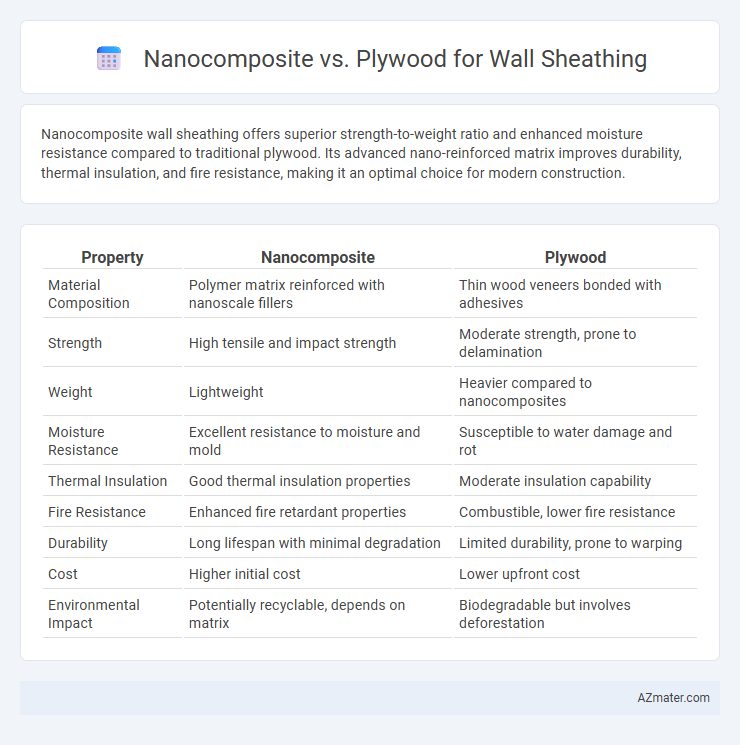Nanocomposite wall sheathing offers superior strength-to-weight ratio and enhanced moisture resistance compared to traditional plywood. Its advanced nano-reinforced matrix improves durability, thermal insulation, and fire resistance, making it an optimal choice for modern construction.
Table of Comparison
| Property | Nanocomposite | Plywood |
|---|---|---|
| Material Composition | Polymer matrix reinforced with nanoscale fillers | Thin wood veneers bonded with adhesives |
| Strength | High tensile and impact strength | Moderate strength, prone to delamination |
| Weight | Lightweight | Heavier compared to nanocomposites |
| Moisture Resistance | Excellent resistance to moisture and mold | Susceptible to water damage and rot |
| Thermal Insulation | Good thermal insulation properties | Moderate insulation capability |
| Fire Resistance | Enhanced fire retardant properties | Combustible, lower fire resistance |
| Durability | Long lifespan with minimal degradation | Limited durability, prone to warping |
| Cost | Higher initial cost | Lower upfront cost |
| Environmental Impact | Potentially recyclable, depends on matrix | Biodegradable but involves deforestation |
Introduction to Wall Sheathing Materials
Wall sheathing serves as a crucial layer in building construction, providing structural support and weather resistance. Nanocomposite materials, featuring nanoscale fillers combined with polymers, offer enhanced durability, moisture resistance, and thermal insulation compared to traditional plywood. Plywood, composed of thin wood veneers bonded together, remains widely used for its affordability and ease of installation despite limitations in water resistance and long-term strength.
Understanding Nanocomposite Sheathing
Nanocomposite sheathing offers enhanced structural strength and superior moisture resistance compared to traditional plywood, making it ideal for wall applications in high-humidity environments. Incorporating nanoparticles such as nanoclay or carbon nanotubes into polymer matrices results in improved thermal insulation and fire retardancy, reducing energy consumption and increasing building safety. The lightweight and durable nature of nanocomposite sheathing extends the lifespan of wall assemblies while minimizing maintenance costs.
Overview of Plywood Sheathing
Plywood sheathing is a traditional construction material composed of thin wood veneers glued together in alternating grain patterns, offering strength and dimensional stability for wall applications. It provides excellent resistance to impact and shear forces, making it a reliable option for structural support and exterior wall coverage. Plywood also allows for easy fastening of siding materials and enhances overall building durability through moisture resistance when properly treated.
Strength and Durability Comparison
Nanocomposite wall sheathing offers superior strength and durability compared to traditional plywood due to its enhanced molecular structure and resistance to moisture and environmental degradation. Plywood's layered wood veneer construction provides decent mechanical strength but is prone to swelling, warping, and delamination under prolonged exposure to humidity and pests. The nanocomposite's resistance to UV radiation, fungal growth, and physical abrasion ensures longer-lasting performance in wall sheathing applications, making it a more reliable choice for structural integrity and longevity.
Moisture Resistance and Weather Performance
Nanocomposite wall sheathing offers superior moisture resistance compared to traditional plywood due to its enhanced polymer matrix that inhibits water absorption and microbial growth. This advanced material maintains structural integrity and dimensional stability under prolonged exposure to humidity and rain, making it highly effective for weather performance. In contrast, plywood tends to swell, delaminate, and deteriorate more quickly when exposed to moisture, reducing its long-term durability in exterior applications.
Insulation and Thermal Efficiency
Nanocomposite materials for wall sheathing offer superior insulation and thermal efficiency compared to traditional plywood due to their enhanced thermal conductivity properties and ability to reduce heat transfer. These materials often incorporate nanoparticles that improve energy retention, resulting in lower heating and cooling costs. Plywood, while durable, lacks the advanced thermal resistance provided by nanocomposites, making nanocomposite sheathing a more effective solution for energy-efficient building envelopes.
Environmental Impact and Sustainability
Nanocomposite wall sheathing offers enhanced durability and insulation properties while reducing the reliance on virgin timber, contributing to lower deforestation rates compared to traditional plywood. Plywood, although biodegradable and sourced from renewable timber, often involves higher energy consumption and chemical treatments that can increase its environmental footprint. Sustainable wall sheathing choices favor nanocomposites for their potential to extend service life and minimize resource depletion, promoting eco-friendly construction practices.
Installation Process and Ease of Use
Nanocomposite panels offer a streamlined installation process due to their lightweight composition and uniform thickness, allowing for faster handling and cutting compared to traditional plywood. Plywood wall sheathing requires more effort during installation because of its heavier weight and susceptibility to warping, which can complicate alignment and fastening. The ease of use of nanocomposite materials is further enhanced by their resistance to moisture and rot, reducing the need for additional treatments or protective measures common with plywood.
Cost Considerations and Long-Term Value
Nanocomposite panels typically present a higher initial cost compared to traditional plywood used for wall sheathing due to advanced material composition and manufacturing processes. However, nanocomposites offer superior durability, moisture resistance, and thermal insulation, potentially reducing maintenance expenses and energy costs over the building's lifespan. Plywood, while cheaper upfront, may incur higher long-term costs from repairs, replacements, and decreased energy efficiency, affecting overall value.
Choosing the Right Sheathing for Your Project
Nanocomposite wall sheathing offers superior moisture resistance and enhanced thermal insulation compared to traditional plywood, making it ideal for projects demanding high durability and energy efficiency. Plywood provides structural stability and cost-effectiveness, often preferred for budget-conscious builds and regions with moderate climate conditions. Selecting the right sheathing depends on project requirements such as environmental exposure, insulation needs, and budget constraints to ensure optimal performance and longevity.

Infographic: Nanocomposite vs Plywood for Wall Sheathing
 azmater.com
azmater.com